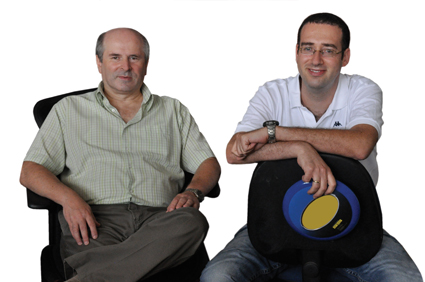And how did he decide where to move?

Frisbee players know that the "secret" to the flying plate heading straight to the pair of hands waiting opposite is turning it at the appropriate angle. Prof. Ilya Aberbuch and research student Erez Gershenval, from the Department of Chemical Physics at the Faculty of Chemistry, used a similar principle in their work with molecules rotating in electric and magnetic fields. Their theoretical research may open the way to various applications in many fields, such as nanotechnology, optics, chemistry and more. In principle, playing with atoms or molecules placed in uniform fields in space should be quite boring: such neutral particles do not notice and do not react when an electric or magnetic field is applied to them, or when a uniform laser is aimed at them. A charged particle, such as an electron, will be accelerated by these fields, but an atom or molecule, whose total electric charge is zero, will remain at rest or continue moving at a constant speed on its way from here to somewhere. This does not mean that neutral particles are not sensitive to the field around them: under the influence of the field they become polar, and their electric charges are separated - the positive charges move to one side of the particle, the negative to the other. The thing is, the forces that act on these charges balance each other, and actually cancel each other's effect. Either way, in the end these atoms and molecules do not feel any urge and "do not feel the need to go anywhere".
Various scientists have made little progress in their attempts to move neutral atoms. The technique developed in this field involves producing a non-uniform field where the force on one side of the polarized atom is stronger than the force on the other side. The stronger force dictates the direction - and the neutral atom moves. Most atoms resemble a round "football" - the polarization can occur in any direction. But even the simplest molecules, such as hydrogen molecules, are characterized by a non-round structure. The hydrogen, for example, looks more like a barbell used in gymnastics. The polar molecules separate their charges to the two ends of the "weight", therefore a molecule standing perpendicular to the field will be affected differently from an identical molecule positioned parallel to it. Prof. Aberbuch and Erez Gershenval understood that, like in a frisbee game, the direction of the molecule's axis and rotation must play a role in the game of moving molecules.
In their theoretical research, the scientists were able to make the molecules spin around any axis they chose, using precise "kicks" of very short laser pulses. Then put these molecules into the uneven field - and let them feel the force.
The molecules did accelerate their movement in the field, but the scientists found that they could control, with great precision, the direction and rate of their movements. "These spinning molecules, which can be polarized, behave like tiny gyroscopes," says Prof. Aberbuch. "The control of the spin axes allows us to direct them exactly wherever we want. We used lasers as the source of the field, but the same principle will work in static electric or magnetic fields."
These findings may pave the way for the development of many applications, and various scientific research groups have already taken an interest in the method. One possibility is the development of molecular optics, which would operate according to rules similar to those of electron microscopy or atomic optics. Such optics may form the basis of new imaging technologies. In the field of nanotechnology, this method may be used to focus beams of swirling molecules on specific targets, and in this way control the deposition process of molecules on a surface.

2 תגובות
Excuse me??
The direction of rotation determines the magnetic polarization of the electron and therefore the behavior in a magnetic field
Sorry for the ignorance, but how can you tell if a tiny particle like an electron is rotating clockwise or counterclockwise?
Thanks to those who answered 🙂